Little Kombucha Scobies For My Friends
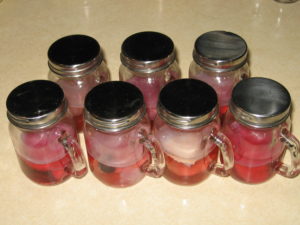
My Little Kombucha Scoby Mugs
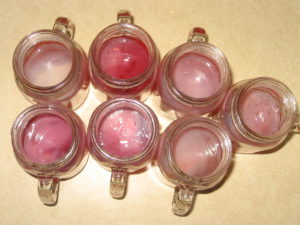
My Little Kombucha Scobies in little glasses
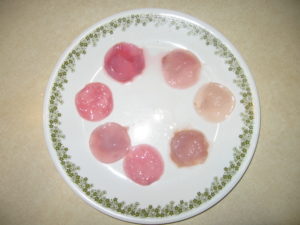
My Little Kombucha Scobies on a plate
I like to give my friends these little mini scobies when I travel, like when I volunteer to do the food at the Victoria Triathlon. So now they will need some instructions on what to do with them to make their own Kombucha with them. So here are my instructions. Enjoy your Kombucha tea and the health it brings you my dear friends.
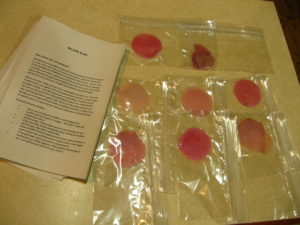
My Little Kombucha Scobies Guidebook
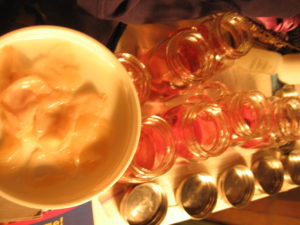
adding scoby starters from my Scoby hotel, to my mini scobies
What is Kombucha Tea?
Kombucha tea is probiotic drink made by fermenting sweetened black or green tea with a flat, solid culture of yeasts and bacteria called the Kombucha SCOBY (SYMBIOTIC COMMUNITY OF BACTERIA AND YEAST).
How to brew your own Kombucha
All you need is a SCOByY, sweet black or green tea and 1/2 cup of liquid from a previous batch of Kombucha (plain store bought Kombucha works too). One scoby will ferment any size batch, though larger batches may take longer. Before you start, make sure you have: a half gallon size glass jar. To make a larger batch, use 1 gallon of brewed sweetened tea (ratio: 1 cup of sugar per gallon of tea). I use plain green tea, or Yerba Mata. The kinds of tea you can use are any kind of unflavored black or green tea. Avoid herbal teas and flavored black or green teas. The fruits, flavorings and oils can damage you’re living Kombucha Scoby. In addition, Rooibos or hibiscus tea or Jasmine pearls ( a type of green tea) work well and are quite delicious.
Kombucha Brewing Wisdom
• Never store Kombucha SCOBYs in the Refrigerator!
• Sanitize with hot water or vinegar – NO SOAP. It kills the kombucha culture.
• Airflow is key – find an open area for your Kombucha Tea.
• If you see mold, throw everything away. Kombucha scobies are not save-able when mold strikes.
• Keep a SCOBY Hotel for backups and extras. (Just put extras in a jar of sweet tea and have extras to give away or start again if one goes bad – give you room to experiment!)
• Kombucha is a LIVING organism. Many believe the energy in the room will directly influence your culture.
Kombucha Ingredients:
• 2 liters (2 quarts) of boiling clean water (not tap or chlorinated water).
• 160 grams (half cup) of sugar
• 6 grams of loose tea or 2-3 teaspoons or 2-3 tea bags (either black or green tea)
• One healthy kombucha Scoby
• 100 ml (0.5 to 1 cup) Kombucha Tea starter (Plain store bought Kombucha is fine) It is also possible to start your own scoby with vinegar added to the sweet tea instead of starter Kombucha tea.
Pour the water over 160 grams (half cup) of sugar into a clean well rinsed (no soap residue) glass, porcelain or Pottery container. stir to dissolve the sugar. The best sugar to use is organic White or organic unrefined sugar but any sugar will do – its not for you its to fee your scoby). . Add the tea to the hot sugar water and let stand for at least 5 minutes. if you prefer to have your green tea less bitter then allow the temperature of the water to cool off a bit first or stop before it come to a full boil. . Strain any loose tea and tea bags from the sweet tea, cover loosely and let sit until room temperature before adding your Kombucha Scoby and starter Kombucha tea. Leave your Kombucha in a warm place with clean air. Tobacco smoke has killed Kombucha scobys.
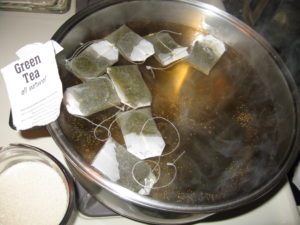
8 bags of green tea cooling for Kombucha scoby
How long to culture a new batch of Kombucha?
Allow your Kombucha to culture 7 to 30 days depending On temperature and taste. the warmer the temperature, the faster the friendly bacteria in the microbes consume the sugar. and the longer you ferment your Kombucha tea, the more sour and less sweet it will taste, consuming all of the sugar and leaving you with a very healthy drink. When done fermenting your Kombucha tea, pour off all but 10% of the liquid into a small mouth bottle, leaving your Kombucha scobies ( there will be a new one forming with each batch), and seal the bottle for a second ferment. The bottle should be stored in the refrigerator otherwise the fermentation process will continue in the beverage will become very sour tasting.
What to do with the Kombucha Scoby? A new batch can be started immediately using the new scoby which grew on top of the liquid. When you first get started, you will have a thin new scoby so what I did was keep using both the new and the old scoby until it got thicker.
If you choose to start more than one batch one with each scoby, then be sure to handle your scoby with clean hands. If no new batches are to be started you can store your kombucha in new sweet tea at room temperature. My original mother scoby, which a friend gave me, when placed in a small jar (planned to become a scoby storage “hotel”) with new tea, made a nice fizzy drink I could not resist drinking.
Natural Soda – Fizzy Kombucha – Second Ferment
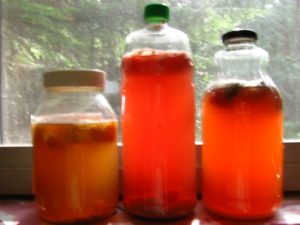
Kombucha second ferment variety
I discovered later this is called a “second ferment” and I was quite lucky. My friend had not got it to become fizzy, even with this same scoby. So much for my first “Scoby hotel” (to store extra scobies). They will remain healthy and alive, even if you do not feed it new sweet tea, even for a long time. It turns out it is better to keep your scoby in very sour old liquid, Kombucha vinegar, then to keep it in the refrigerator. You will find you need more and more to drink over time, especially as family and friends start. You may gradually increase the amount of Kombucha tea you drink yourself. Start slowly with a few sips a day, until you can drink 3 glasses daily, one before breakfast, (helps kick start digestion), and one with or after each meals. The more experience you have the better the result will get. so get started and get healthy.
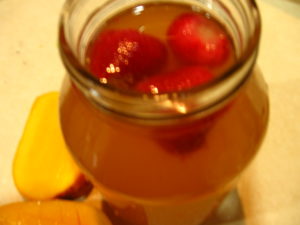
Homemade Strawberry Mango Kombucha “Soda”
Perfect Temperature for My Little Kombucha Scoby
The ideal temperature for fermenting kombucha is 70 to 82 degrees Fahrenheit (23 to 28 degrees Centigrade). This temperature is not the normal average in most parts of the world so take note it does not matter so much if the temperature varies from a low of 57 degrees Fahrenheit (14 degrees Centigrade) at night, to a temperature over 28 degrees Centigrade (82 F) during the day. When the temperature is too low, the brew will stop fermenting. If room temperature in daytime is over 36 degrees Centigrade or 97 degrees Fahrenheit, this does not mean that your brew would not ferment properly. A very high temperature will result in higher evaporation of water. Some people from tropical countries report that they lose 25% of their brew during fermentation. However, one recommendation is leaving the container for one week in a cool place to start when brewing in very hot areas. It could be dangerous if too hot in the first days of fermentation where an ideal fermentation temperature is very important to avoid contamination. In cooler temperatures you’ll need more time to ferment a healthy kombucha drink. One should not go by the brewing time alone. In different areas and at different times of the year adjustments have to be made. Judge by the taste and appearance of your brew.
Kombucha Container Recommendations
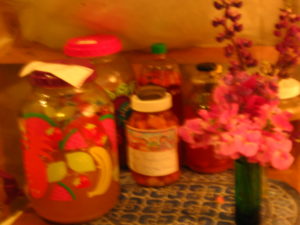
Continuous brew and 2nd ferment Kombucha
The best container for brewing Kombucha is glass. You can also use porcelain or glazed pottery. However, avoid metal and plastic. Metal containers are not used for a couple reasons. The acid in your kombucha will react with metal, for one thing. Kombucha brewed in stainless steel containers does not taste as good as that grown in the recommended type of container such as glass. Also the metal ions could actually kill off the live culture. And plastic is not recommended, as polyvinyl polypropylene and cheap Plastics can cause chemical reactions in the brew, also contaminating it for drinking.
Kombucha Container
Shape A culture needs a large surface area for it to grow quickly. Your Kombucha fermenting containers should have a wide opening, not too tall and not filled up to the top. It needs to breath, so leave air space at the top. A wider opening ferments your tea more quickly and much better. Both metal and plastic can introduce harmful chemicals that may destroy you’re living culture and be bad for your health.
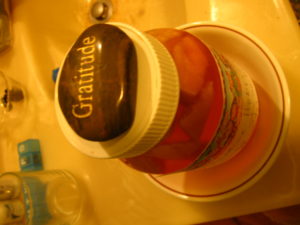
Gratitude for Kombucha and mango
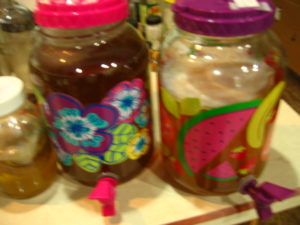
Continuous Brew Kombucha my 2, 2 Gallon Jars
Continuous Brew Method
Continuous Brew methods require a glass ceramic or porcelain container with a spout to allow the draining of the finished Brew. Ideally you will not take the scoby out of the pot if there is no reason to do so . separating the culture after every week or so is another unnecessary task leave the culture alone and let it work without interfering. Only time when you need to take this scoby out of your container is when it grows to the point where it takes too much of the fermentation space you need for Brewing. If your scoby grows too big take it out and only separate a little piece of the culture which you then put back in the continuous fermenting containers. Store extra scobies in a jar (Scoby Hotel) with Kombucha vinegar until you need it. Do not sore in the refrigerator. Every once in awhile, take one of 2 out of the hotel and feed your extra scobies new sweet tea to experiment with different kinds of teas (Jasmine pearls, white peony, rooibos, hibiscus) and new 2nd ferment flavor combinations (ginger and other herbs with various fruit combinations) for delicious and creative new drinks. If you kill one, you have plenty more scobies in your Scoby Hotel.
Lastly…
To discover more Kombucha tips and recipes, visit my Kombucha category here.

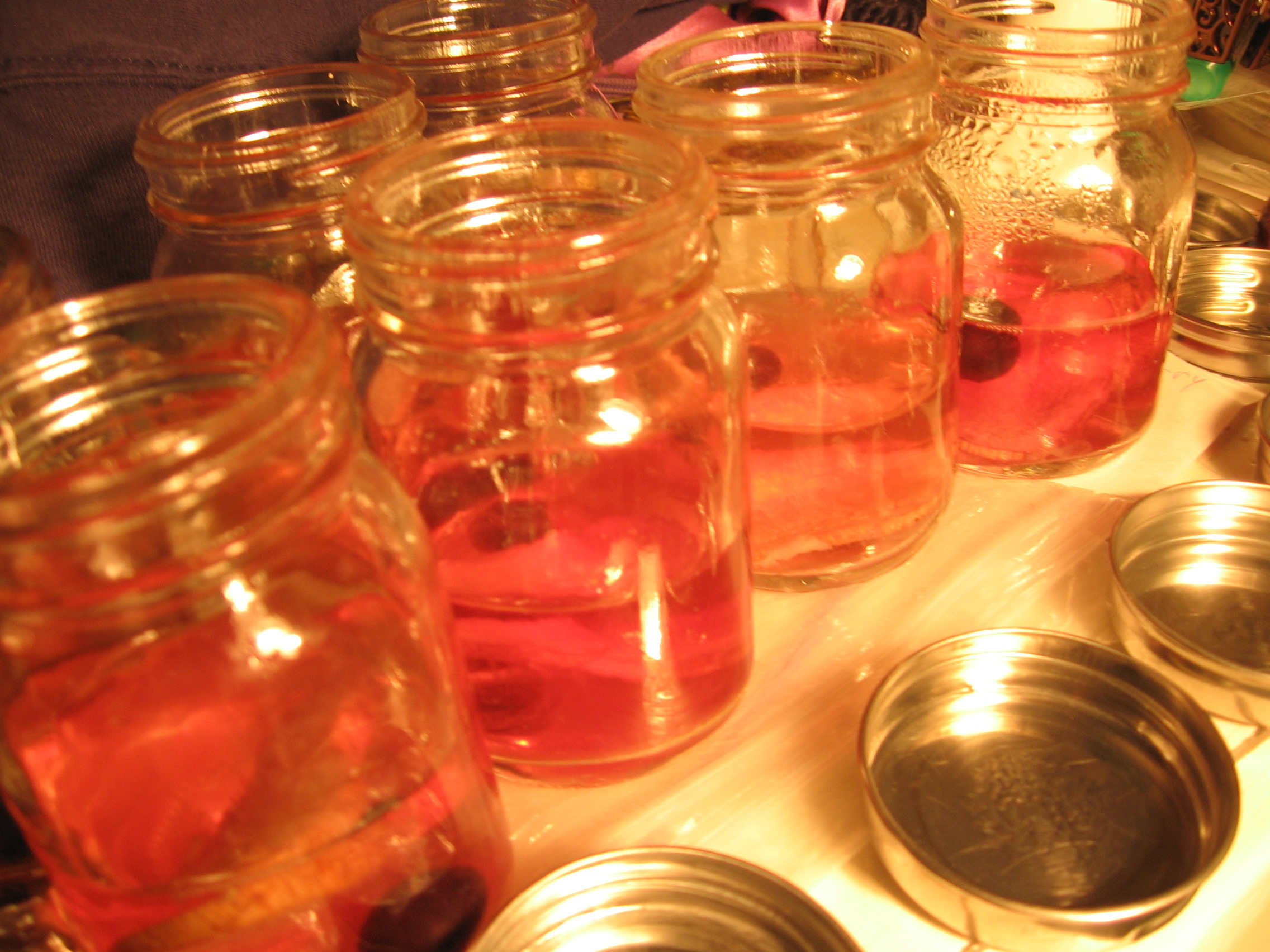
Recent Comments